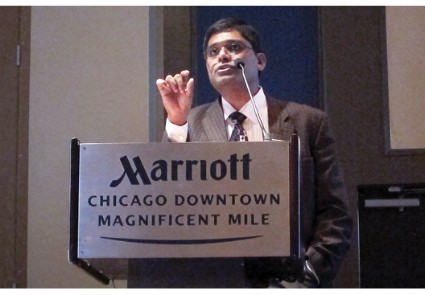User login
CHICAGO – The growing number of endovascular interventions over the past 2 decades has changed the face of surgery, but also has brought with it increased radiation exposure for patients, surgeons, and medical personnel involved in patient care.
"It’s unwanted baggage. The downside of more endovascular procedures is more radiation exposure" said Dr. Raghu L. Motaganahalli, with Indiana University School of Medicine, in Indianapolis.
The most recent 2009 report from the National Council on Radiation Protection and Measurements says the average effective dose received by Americans from medical uses, excluding radiotherapy, is 3.0 millisieverts or essentially the same as that received from natural background radiation.
Still, the use of computed tomography imaging has doubled every 2 years since the early 1980s to nearly 70 million scans in 2007 and at least 2% of all cancers are estimated to caused by CT radiation scan exposure, he said.
While patient exposure garners the lion’s share of attention, Dr. Motaganahalli urged surgeons at the annual meeting of the Midwestern Vascular Surgical Society to play a more active role in reducing radiation exposure. Personal monitoring is the first step, with the nonprofit International Commission on Radiological Protection recommending the use of two dosimeters – one at the neck and the second under the lead shielding at the waist – for the greatest measurement accuracy.
Lead aprons should be worn by all medical staff within about six feet of the patient, while thyroid collars and lead glasses also should be part of protective gear to reduce the risk of cancers or cataracts.
Distance from the radiation source in the interventional suite is also critical, he said. A recent study demonstrated that radiation doses vary widely around the perimeter of the angiography table and change according to the imaging angle (J. Vasc. Surg. 2013 [doi:10.1016/j.jvs.2013.01.025]).
The highest radiation doses were seen on the emitter side of the table, and thus, special emphasis should be paid to moving staff away from the scatter source, that is the patient, when standing on this side of the table, Dr. Motaganahalli said.
Other efforts to reduce radiation scatter to staff include minimizing the use of fluoroscopy and digital acquisition ("cine") times. The dose rate during a cine run is 10-20 times that during fluoroscopy. Using the "last image hold" capabilities may reduce the need for additional fluoroscopic time.
Pulsed fluoroscopy is also a better option than continuous fluoroscopy because the short bursts of x-ray decrease the exposure time and radiation exposure to the patient, he said. If the pulse rate is increased to approximately 30 pulses per second, however, the dose rate is virtually equivalent to that of continuous fluoroscopy.
High-dose fluoroscopy should be reserved for procedures requiring very high levels of detail because it allows exposure rates of up to 20 roentgens (R) per minute, whereas the normal operating mode is limited to 10 R/min., the Food and Drug Administration limit, Dr. Motaganahalli said.
Similarly, the use of magnification modes should be limited to the extent practicable because higher magnification modes result in higher radiation doses to smaller areas of the skin.
The "good news" is that vascular surgeons are exposed to about 70% of the ICRP occupational exposure limits over a 1-year-period (J. Vasc. Surg. 2000;32:704-10), he said. A more recent study reports even lower effective eye and hand doses, even after adjustments for longer fluoroscopy time, possibly because of extra protective devices such as a table-side lead shield and mobile lead shield reducing scatter radiation (J. Vasc. Surg. 2007;46:455-9).
A number of protection devices have been created including portable shields, under-table shields, lead caps, and zero gravity lead suits, although audience members commented that the suit has proven too unwieldy for practical use.
Dr. Motaganahalli reported having no conflicts of interest.
CHICAGO – The growing number of endovascular interventions over the past 2 decades has changed the face of surgery, but also has brought with it increased radiation exposure for patients, surgeons, and medical personnel involved in patient care.
"It’s unwanted baggage. The downside of more endovascular procedures is more radiation exposure" said Dr. Raghu L. Motaganahalli, with Indiana University School of Medicine, in Indianapolis.
The most recent 2009 report from the National Council on Radiation Protection and Measurements says the average effective dose received by Americans from medical uses, excluding radiotherapy, is 3.0 millisieverts or essentially the same as that received from natural background radiation.
Still, the use of computed tomography imaging has doubled every 2 years since the early 1980s to nearly 70 million scans in 2007 and at least 2% of all cancers are estimated to caused by CT radiation scan exposure, he said.
While patient exposure garners the lion’s share of attention, Dr. Motaganahalli urged surgeons at the annual meeting of the Midwestern Vascular Surgical Society to play a more active role in reducing radiation exposure. Personal monitoring is the first step, with the nonprofit International Commission on Radiological Protection recommending the use of two dosimeters – one at the neck and the second under the lead shielding at the waist – for the greatest measurement accuracy.
Lead aprons should be worn by all medical staff within about six feet of the patient, while thyroid collars and lead glasses also should be part of protective gear to reduce the risk of cancers or cataracts.
Distance from the radiation source in the interventional suite is also critical, he said. A recent study demonstrated that radiation doses vary widely around the perimeter of the angiography table and change according to the imaging angle (J. Vasc. Surg. 2013 [doi:10.1016/j.jvs.2013.01.025]).
The highest radiation doses were seen on the emitter side of the table, and thus, special emphasis should be paid to moving staff away from the scatter source, that is the patient, when standing on this side of the table, Dr. Motaganahalli said.
Other efforts to reduce radiation scatter to staff include minimizing the use of fluoroscopy and digital acquisition ("cine") times. The dose rate during a cine run is 10-20 times that during fluoroscopy. Using the "last image hold" capabilities may reduce the need for additional fluoroscopic time.
Pulsed fluoroscopy is also a better option than continuous fluoroscopy because the short bursts of x-ray decrease the exposure time and radiation exposure to the patient, he said. If the pulse rate is increased to approximately 30 pulses per second, however, the dose rate is virtually equivalent to that of continuous fluoroscopy.
High-dose fluoroscopy should be reserved for procedures requiring very high levels of detail because it allows exposure rates of up to 20 roentgens (R) per minute, whereas the normal operating mode is limited to 10 R/min., the Food and Drug Administration limit, Dr. Motaganahalli said.
Similarly, the use of magnification modes should be limited to the extent practicable because higher magnification modes result in higher radiation doses to smaller areas of the skin.
The "good news" is that vascular surgeons are exposed to about 70% of the ICRP occupational exposure limits over a 1-year-period (J. Vasc. Surg. 2000;32:704-10), he said. A more recent study reports even lower effective eye and hand doses, even after adjustments for longer fluoroscopy time, possibly because of extra protective devices such as a table-side lead shield and mobile lead shield reducing scatter radiation (J. Vasc. Surg. 2007;46:455-9).
A number of protection devices have been created including portable shields, under-table shields, lead caps, and zero gravity lead suits, although audience members commented that the suit has proven too unwieldy for practical use.
Dr. Motaganahalli reported having no conflicts of interest.
CHICAGO – The growing number of endovascular interventions over the past 2 decades has changed the face of surgery, but also has brought with it increased radiation exposure for patients, surgeons, and medical personnel involved in patient care.
"It’s unwanted baggage. The downside of more endovascular procedures is more radiation exposure" said Dr. Raghu L. Motaganahalli, with Indiana University School of Medicine, in Indianapolis.
The most recent 2009 report from the National Council on Radiation Protection and Measurements says the average effective dose received by Americans from medical uses, excluding radiotherapy, is 3.0 millisieverts or essentially the same as that received from natural background radiation.
Still, the use of computed tomography imaging has doubled every 2 years since the early 1980s to nearly 70 million scans in 2007 and at least 2% of all cancers are estimated to caused by CT radiation scan exposure, he said.
While patient exposure garners the lion’s share of attention, Dr. Motaganahalli urged surgeons at the annual meeting of the Midwestern Vascular Surgical Society to play a more active role in reducing radiation exposure. Personal monitoring is the first step, with the nonprofit International Commission on Radiological Protection recommending the use of two dosimeters – one at the neck and the second under the lead shielding at the waist – for the greatest measurement accuracy.
Lead aprons should be worn by all medical staff within about six feet of the patient, while thyroid collars and lead glasses also should be part of protective gear to reduce the risk of cancers or cataracts.
Distance from the radiation source in the interventional suite is also critical, he said. A recent study demonstrated that radiation doses vary widely around the perimeter of the angiography table and change according to the imaging angle (J. Vasc. Surg. 2013 [doi:10.1016/j.jvs.2013.01.025]).
The highest radiation doses were seen on the emitter side of the table, and thus, special emphasis should be paid to moving staff away from the scatter source, that is the patient, when standing on this side of the table, Dr. Motaganahalli said.
Other efforts to reduce radiation scatter to staff include minimizing the use of fluoroscopy and digital acquisition ("cine") times. The dose rate during a cine run is 10-20 times that during fluoroscopy. Using the "last image hold" capabilities may reduce the need for additional fluoroscopic time.
Pulsed fluoroscopy is also a better option than continuous fluoroscopy because the short bursts of x-ray decrease the exposure time and radiation exposure to the patient, he said. If the pulse rate is increased to approximately 30 pulses per second, however, the dose rate is virtually equivalent to that of continuous fluoroscopy.
High-dose fluoroscopy should be reserved for procedures requiring very high levels of detail because it allows exposure rates of up to 20 roentgens (R) per minute, whereas the normal operating mode is limited to 10 R/min., the Food and Drug Administration limit, Dr. Motaganahalli said.
Similarly, the use of magnification modes should be limited to the extent practicable because higher magnification modes result in higher radiation doses to smaller areas of the skin.
The "good news" is that vascular surgeons are exposed to about 70% of the ICRP occupational exposure limits over a 1-year-period (J. Vasc. Surg. 2000;32:704-10), he said. A more recent study reports even lower effective eye and hand doses, even after adjustments for longer fluoroscopy time, possibly because of extra protective devices such as a table-side lead shield and mobile lead shield reducing scatter radiation (J. Vasc. Surg. 2007;46:455-9).
A number of protection devices have been created including portable shields, under-table shields, lead caps, and zero gravity lead suits, although audience members commented that the suit has proven too unwieldy for practical use.
Dr. Motaganahalli reported having no conflicts of interest.

